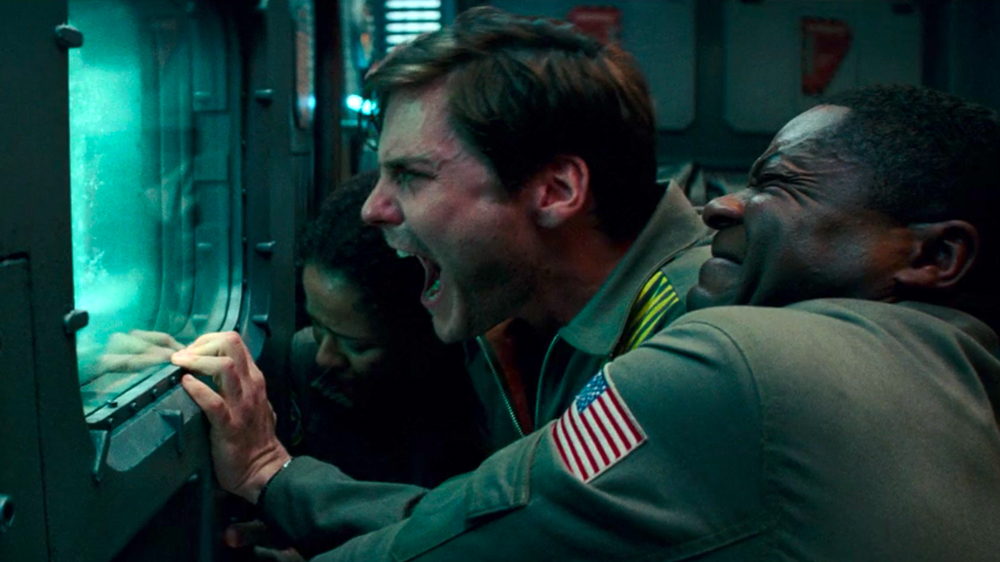I’m attracted to the kinds of transgressive, subversive movies that Joe Bob Briggs curates in his TV and live shows because they’re like a pressure release valve. They let us laugh and be shocked and be grossed-out in a safe environment. They, like virtually all movies, allow me to experience the world in a way that is radically different from how I experience it. They overturn the acceptable behavior – or, more often, show it for the hypocrisy it often is – of square society. (And, yes, I realize that I’m about the squarest person you could ever meet, which adds to the appeal of these movies for me.)
I can’t think of a better overseer for these dubious masterpieces than the man, the myth, the legend, Joe Bob Briggs. In his immortal words, “The drive-in will never die!”
Read more…
At about 30 minutes into The Cloverfield Paradox, I had one of those moments that often comes along when I’m watching an entertaining bit of genre filmmaking. I took a moment to appreciate how much I was enjoying the experience by mentally telling myself, “I am really into this.” Then, as is often the case with most storytelling, the plot of the movie had to kick in, and things started to go a little haywire. By the end, it was clear just how much of a disaster this movie was. Its plot is nonsensical to the point of being moronic. At least some of Paradox’s coherence problem was made worse because the producers – most notably J.J. Abrams – decided to tie this stand-alone sci-fi movie into the Cloverfield series during filming. This led to the film’s writer, Oren Uziel, penning new scenes and rewriting others, and the director, Julius Onah, shooting those changes in order to make Paradox – originally titled God Particle – fit into the Cloverfield universe. The result is an utter mess of a movie.
Read more...
When the credits suddenly rolled at the end of Dangerous Men, my response was to yell “Yes! YES!” at the top of my lungs. No one else in the theater noticed, they were all too busy having their own ecstatic reactions, laughing and applauding in equal measure. Simply put, Dangerous Men is one of the most indecipherable, comically bad movies ever committed to celluloid.
The movie’s plot – what little there is – concerns a woman, Mira, and her fiancé being attacked on a beach by two bikers. The fiancé is killed, and the bikers plan to rape Mira. She cunningly escapes being violated and goes on a mission to get revenge on every man with nefarious intentions she comes across. To describe what happens next as “incomprehensible” is like suggesting that reading The Canterbury Tales in Chaucer’s original Middle English is a bit tough to get through.
There’s no story in Dangerous Men, so much as there are several story threads that are tenuously tied at best. The movie cuts between each one at break-neck speed until the final scene ends in the most abrupt way possible: freeze-framing on three characters we’ve only just been introduced to. It’s as if the idea of dramatic resolution was a physical entity that committed such a heinous crime against the filmmaker, he had no choice but to get his revenge with a bad enough ending that storytelling itself would be mortally wounded.
The auteur responsible for Dangerous Men, Iranian born architect John S. Rad, spent 26 years making his movie, and ultimately self-financed its initial disastrous theatrical run. Rad – born Jahangir Yeganehrad – began filming his trash opus in the early ‘80s, giving the whole film its grungy neon aesthetic. He refused to be buried in debt, so filming became a start-and-stop endeavor, depending on when he had the cash on hand to afford it. Rad completed filming in the mid-90s, and he had to pay out-of-pocket to get the finished product into a few L.A. theaters in 2005. The filmmaker died of a heart attack in 2007, just a few years after Dangerous Men started earning a reputation on the cult, so-bad-it’s-good midnight movie circuit.
Read more...



